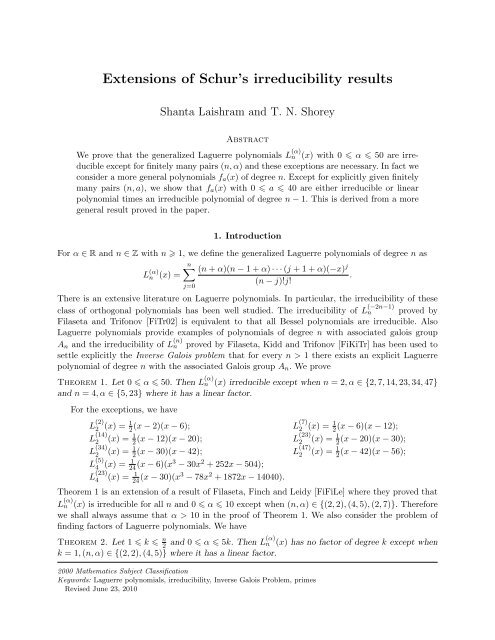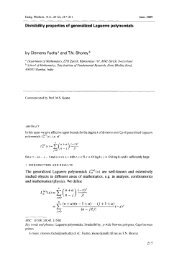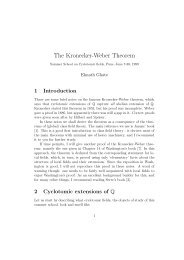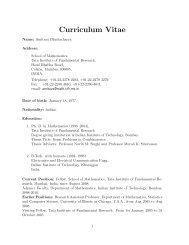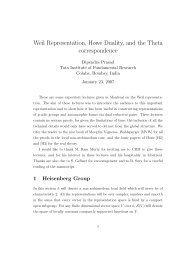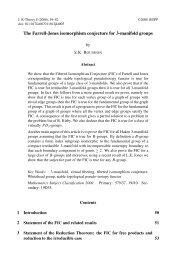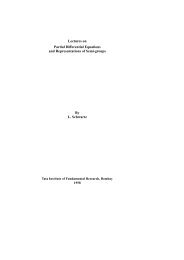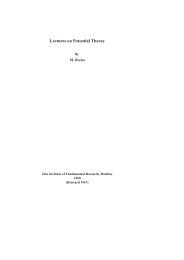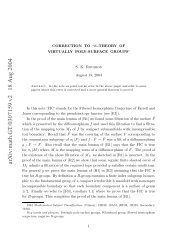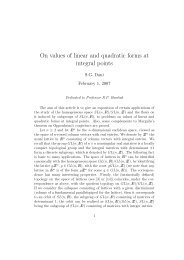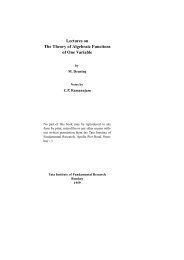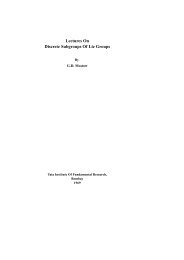Extensions of Schur's irreducibility results - Tata Institute of ...
Extensions of Schur's irreducibility results - Tata Institute of ...
Extensions of Schur's irreducibility results - Tata Institute of ...
Create successful ePaper yourself
Turn your PDF publications into a flip-book with our unique Google optimized e-Paper software.
Shanta Laishram and T. N. Shorey2. Pro<strong>of</strong> <strong>of</strong> Lemma 1We will use the notations introduced in this section throughout the paper. We write∆ j = ∆(a + 1, j) = (a + 1)(a + 2) · · · (a + j).We observe that q|∆ k for all primes k < q a+k ⌈u 0⌉ since a k ⌈ u 0⌉< q⌈u0⌉ a + k. Suppose thereis a prime p satisfying the condition <strong>of</strong> the lemma. Then p > a+k ⌈u 0⌉. As in the pro<strong>of</strong> <strong>of</strong> [ShTi, Lemma4.2], it suffices to show that(11)φ j := φ j (p) := ord p(∆ j )j< 1 k for 1 j nfor showing that f a (x) has no factor <strong>of</strong> degree k. Also as in the pro<strong>of</strong> <strong>of</strong> [FiFiLe, Lemma 2.4], forshowing L (a)n (x) has no factor <strong>of</strong> degree k, it suffices to show( )∆ord j pφ ′ j := φ ′ ( n(12)j)j(p) :=< 1 for 1 j n.j kSince φ ′ j φ j, we show that (11) holds for all j.Let j 0 be the minimum j such that p|(a + j) and write a + j 0 = pl 0 for some l 0 . Then j 0 p andj 0 > k since p ∤ ∆ k . Also we see that l 0 ⌈ u 0⌉which we shall use in the pro<strong>of</strong> without reference.We may restrict to those j such that a + j = pl for some l. Then j − j 0 = p(l − l 0 ). Writingl = l 0 + s, we get j = j 0 + ps. Note that if p|(a + j), then a + j = p(l 0 + r) for some r. Hence wehave(13)ord p (∆ j ) = ord p ((pl 0 )(p(l 0 + 1)) · · · (p(l 0 + s))) = s + 1 + ord p (l 0 (l 0 + 1) · · · (l 0 + s)).Let r 0 be such that ord p (l 0 + r 0 ) is maximal. We consider two cases.Case I: Assume that l 0 + s < p 2 . If p ∤ (l 0 + i) for 0 i s, then φ j = s+1j 0 +ps < s+1k+ks = 1 k . Hencewe may suppose that p|(l 0 + i) for some 0 i s and further l 0 + s = pl 1 for some 1 l 1 < p.Assume s = 0. Then p|l 0 which together with l 0 < p 2 implies ord p (∆ j ) =ord p (a + j 0 ) = 2. Thereforea + p a + j 0 p 2 implying a p 2 − p. If (8) holds, then a max(k(p − k), pk 2) < p(p − 1) whichis not possible. Thus (9) holds and hence p 2k + 1 and a = p 2 − p implying j 0 = p. Thereforeφ j = 2 j 0= 2 p < 1 k . Thus we have s ≠ 0 and we obtain from (13) that ord p(∆ j ) = s + 1 + l 1 implyingφ j s+1+l 1j 0 +ps . Hence φ j < 1 skif (p − k)l 1 k since j 0+spk> 1 + s p k .Suppose p satisfy (9). Then we may assume that s < l 1 . Since l 1 < p, we have s < p implyingord p (∆ j ) s + 2 giving φ j < s+2k+ps 1 ksince s > 0.Thus we assume that p satisfy (8). Since p k + 2, s = pl 1 − l 0 and l 0 ⌈ ⌉u 0 , we have(p − k) sl 1− k 2(p − l 0l1) − k 2p − k − 2 ⌈ ⌉ ⌈ ⌉u 0 . Hence it suffices to show 2p − k 2 u0 . Sincep min(2u 0 , k + u 0 ), we have{2u 0 + 2 2 ⌈ ⌉u 0 if p 2u 02p − k = p + p − k 2(k + ⌈ ⌉ ⌈ ⌉u 0 ) − k 2 u0 if p k + u 0 ,noting that p k + u 0 implies p k + ⌈ u 0⌉.Case II: Let l 0 + s p 2 . Then we get from (13) thatord p (∆ j ) s + 1 + ord p (l 0 + r 0 ) + ord p (s!) s + 1 + log(l 0 + s)log p4+ sp − 1 .
Since j k = j 0+pskObserve that log(l 0+s)s log p<strong>Extensions</strong> <strong>of</strong> Schur’s <strong>irreducibility</strong> <strong>results</strong>> 1 + p ks, it is enough to show thatpk 1 + 1p − 1 + log(l 0 + s)s log pis a decreasing function <strong>of</strong> s. Since s p 2 − l 0 , it suffices to showpk 1 + 1p − 1 + 2p 2 .− l 0Suppose p satisfy (8). Then from l 0 ⌈ u 0⌉ p and p k + 2, we have p 2 − l 0 (k + 2) 2 − (k + 2) 2(k + 1) implying1 + 1p − 1 + 2p 2 − l 0 1 + 1k + 1 + 22(k + 1) < 1 + 2 k p k .Suppose p satisfy (9). Then from l 0 ⌈ u 0⌉ a and p > 2k, we obtain p 2 − l 0 p 2 − a p > 2kimplyingHence the assertion.Corollary 2.1. Let k, p and A k,p be given by1 + 1p − 1 + 2p 2 − l 0 1 + 12k + 22k < 1 + 2 k p k .k = 1, p = 3, A 1,3 = {3r, 3r + 1 : 0 r 16} \ {7, 16, 24, 25, 34, 43}k = 1, p = 5, A 1,5 = {5r, 5r + 1, 5r + 2, 5r + 3 : 0 r 9} ∪ {50} \ {23, 48}k = 1, p = 7, A 1,7 = [0, 50] ∩ Z \ {6, 13, 20, 27, 34, 41, 47, 48}k = 2, p = 5, A 2,5 = {5r, 5r + 1, 5r + 2 : 0 r 8} ∪ {45, 50} \ {21, 22}k = 2, p = 7, A 2,7 = [0, 50] ∩ Z \ ({7r − 1, 7r − 2 : 1 r 7} ∪ {45, 46})k = 3, p = 5, A 3,5 = {0, 1, 5, 6, 10, 11, 15, 25, 26, 30, 31, 35, 36, 40, 50}k = 3, p = 7, A 3,7 = {7r, 7r + 1, 7r + 2, 7r + 3 : 0 r 5} ∪ {42, 49, 50}k = 4, p = 7, A 4,7 = {7r, 7r + 1, 7r + 2 : 0 r 4} ∪ {35, 36, 49, 50}k = 5, p = 7, A 5,7 = {0, 1, 7, 8, 14, 15, 21, 22, 28, 49, 50}.Suppose n 2k and p satisfies (6). Then f a (x) has no factor <strong>of</strong> degree k for a ∈ A k,p . Further if psatisfy (10), then L (a)n (x) has no factor <strong>of</strong> degree k for a ∈ A k,p .Pro<strong>of</strong>. For k, p and a ∈ A k,p given in the statement <strong>of</strong> Corollary 2.1, we check that p ∤ ∆ k andord p(∆ j )j< 1 k for j 50. As in the pro<strong>of</strong> <strong>of</strong> Lemma 1, it suffices to check that ordp(∆ j)j< 1 kfor allj 1. Since ord p (s!) , we have for j > 50 thatord p (∆ j )jThus ordp(∆ j)j< 1 ksp−1= ord p((a + j)!) − ord p (a!)jfor all j 1.Corollary 2.2. Let a > 0 and 1 k n 2 .a+jp−1 − ord p(a!) 1j p − 1 +.ap−1 − ord p(a!)< 1 51 k .(i) If there is a prime p > a + k satisfying (6), then f a (x) has no factor <strong>of</strong> degree k.(ii) Let p k + 2 be a prime satisfying (6) and letA p =r p⋃i=1([ip − k, ip − 1] ∩ Z >0 ) ⋃ {j > pr p , j ∈ Z}5✷
whereShanta Laishram and T. N. Shoreyr p = ⌊ k ⌋if p < 2k and p − 1 if p 2k.2Then f a (x) has no factor <strong>of</strong> degree k for a /∈ A p .(iii) Let P 1 > P 2 > . . . > P s k + 2 be primes satisfying (6). For a subset {Q 1 , Q 2 , . . . , Q g } ⊆{P 1 , P 2 , . . . , P s }, letB{Q 1 , . . . , Q g } =g⋂A Ql .Then f a (x) has no factor <strong>of</strong> degree k for a /∈ B{Q 1 , . . . , Q g }.l=1In earlier <strong>results</strong>, Corollary 2.2 (i) has been used. This is possible only if there is a p > k + asatisfying (6). But it is possible to apply Lemma 1 even when p k + a for all p satisfying (6). Forexample, take n = 15, a = 13, k = 3. Here p < k + a for all p satisfying (6). However (6), (7) and(9) are satisfied with p = 13 and hence f 13 (x) has no factor <strong>of</strong> degree 3 by Lemma 1.Pro<strong>of</strong>. (i) is immediate from Lemma 1. Consider (ii). We may assume that p k + a by (i). Leta /∈ A p . Then a pr p implying a p 2 − p if p 2k and 2u 0 = 2a k 2prpk p if p < 2k satisfyingeither (9) or (8). Since a /∈ A p , there is some i for which ip − 1 < a < (i + 1)p − k implyingip < a + 1 < a + k < (i + 1)p. Therefore p ∤ ∏ kj=1(a + j) which together with (6) and p k + 2satisfy the conditions <strong>of</strong> Lemma 1. Now the assertion follows by Lemma 1. The assertion (iii) followsfrom (ii).Let m, k and t be positive integers such that3. An upper bound for m when ω(∆(m, k)) t(14)ω(∆(m, k)) tand we writev = m k .For every prime p dividing ∆(m, k), we delete a term m + i p in ∆(m, k) such that ord p (m + i p ) ismaximal. Then we have a set T <strong>of</strong> terms in ∆(m, k) with|T | = k − t := t 0 .We arrange the elements <strong>of</strong> T as m + i 1 < m + i 2 < · · · < m + i t0 . Let(15)P :=t 0 ∏ν=1(m + i ν ) (vk) t 0.Now we obtain an upper bound for P. For a prime p, let r be the highest power <strong>of</strong> p such thatp r k − 1. Let w l = #{m + i : p l |(m + i), m + i ∈ T } for 1 l r. By Sylvester and Erdősargument, we have w l [ i 0p l ] + [ k−1−io ] [ k−1 ]. Let hp l p lp > 0 be such that [ k−1 ] tp hp+1 0 < [ k−1 hp ]. Thenp6
<strong>Extensions</strong> <strong>of</strong> Schur’s <strong>irreducibility</strong> <strong>results</strong>there are at most t 0 − w hp+1 terms in T exactly divisible by p l with l h p . Henceord p (P) rw r +u=1∑r−1u=h p+1u(w u − w u+1 ) + h p (t 0 − w hp+1)= w r + w r−1 + · · · + w hp+1 + h p t 0h r∑ ⌊k − 1⌋ ph∑ ⌊k − 1⌋ ∑ p⌊k − 1⌋ + hpp u t 0 −= ordpp u ((k − 1)!) + h p t 0 −.p uu=1It is also easy to see that ord p (P) ord p (k − 1)!). Let L 0 (p) =min(0, h p t 0 − ∑ h pl 1, we have from (15) that⎛⎞ 1(16)m = vk (P) 1t 0 ⎝(k − 1)! ∏ p L 0(p) ⎠pp lt 0=: L(k, l).u=1u=1⌊ k−1⌋p ). For anyuObserve that(17)(vk) t 0 (L(k, l)) t 0 (k − 1)!.4. Preliminaries for Theorems 3-2For a positive integer ν > 1, we denote by ω(ν) and P (ν) the number <strong>of</strong> distinct prime factors andthe greatest prime factor <strong>of</strong> ν, respectively, and we put ω(1) = 0, P (1) = 1. For positive integers ν,we writeπ(ν) = ∑ pν1,θ(ν) = ∑ pνlog p.Let p i denote the i − th prime.We begin with some <strong>results</strong> on prime number theory.Lemma 4.1. Let k ∈ Z and ν ∈ R. We have( )νν(i)log ν−1 π(ν) log ν1 + 1.2762log ν.ν5393 ν>1(ii) π(ν 1 + ν 2 ) π(ν 1 ) + π(ν 2 ) for 2 ν 1 < ν 2 7 5 ν 1(log ν 1 )(log log ν 1 ).(iii) ν(1 − 3.965 ) θ(ν) < 1.00008ν for ν > 1.log 2 ν(iv) p k k log k for k 1.(v) ord p (k − 1)! k−pp−1 − log(k−1)log pfor k 2.(vi) √ 2πk e −k k k e 112k+1 < k!
Shanta Laishram and T. N. ShoreyPro<strong>of</strong>. Let 10 10 < m 123 × k. We observe that the assertion holds ifθ( m + k − 1 ) − θ( m − 1 ∑) =log p > 0ssθ( m + k − 1s) − θ( m − 1 ) > m + k − 1s sm−1 10 10 , it suffices to show(1 −ork(1 −This is true since m 123k and3.965log 2 (5 · 10 9 )3.9658log 2 ) > (m − 1)((5 · 10 9 ) 10 5 + 3.965log 2 (5 · 10 9 ) ).1 − 3.965log 2 (5·10 9 )8+ 3.96510 5 log 2 (5·10 9 )> 123.)− 1.00008 m − 1 > 0sCorollary 4.3. We have(18)π(k) + π( k 2 ) + π(k 3 ) + π(k 4 ) + π(6k 5 ) {k − 2 for k 61π(4k) for k 8000.Pro<strong>of</strong>. Let k 30000. We have from log y log y/xlog x= 1 +log xand Lemma 4.1 (i) that(log 4k)(π(4k) − π( 6k )5 ) − π(k) − π(k 2 ) − π(k 3 ) − π(k 4 )4klog 4k − 1 +⎛ (k ⎝4 − 6 51 + log 10 3log 6k 5) (1 + 1.2762log 6k 5)−4∑j=1(11 +j) (log 4jlog k j1 + 1.2762log k jThe right hand side <strong>of</strong> the above inequality is an increasing function <strong>of</strong> k and it is positive atk = 30000. Therefore the left hand side <strong>of</strong> (18) is at most π(4k) for k 30000. By using exactvalues, we find that it is valid for k 8000.Also π(4k) 4klog 4k(1 + 1.2762log 4k) ⎞ ⎠ .) k − 2 is true for k 8000. Therefore the left hand side <strong>of</strong> (18)is at most k − 2 for k 8000. Finally we check using exact values <strong>of</strong> π function that the left handside <strong>of</strong> (18) is at most k − 2 for 61 k < 8000.The following result is on Grimm’s Conjecture, [LaSh06b, Theorem 1].Lemma 4.4. Let m 1.9 × 10 10 and l 1 be such that m + 1, m + 2, · · · , m + l are all compositenumbers. Then there are distinct primes P i such that P i |(m + i) for each 1 i l.The following result follows from [SaSh03, Lemma 3].Lemma 4.5. Let m + k − 1 < k 3 2 . Let |{i : P (m + i) k}| = µ. Then( )m + k − 1 (2.83) k+√m+k−1 (m + k − 1) k−µ .k8
<strong>Extensions</strong> <strong>of</strong> Schur’s <strong>irreducibility</strong> <strong>results</strong>5. Prelude to the pro<strong>of</strong> <strong>of</strong> Theorems 3-5Let k 2, n 2k, a 0, m = n + a − k + 1 and |a 0 a n | = 1. Then m > k + a. We consider thepolynomials f a (x) with 3 < a 40 when k = 2; 10 < a 50 when k ∈ {3, 4} and max(30, 1.5k) P 2 > . . . > P s k + 2 be primes dividing ∆(m, k) andwe write P m,k = {P 1 , P 2 , . . . , P s }. We use Corollaries 2.2 and 2.1 to apply the following procedurewhich we refer to as Procedure I.Procedure I: Let k be fixed. For all a with 3 < a 40 if k = 2; 10 < a 50 if k ∈ {3, 4} andmax(30, 1.5k) < a max(50, 5k) if k 5, it suffices to consider all (m, k, a) with P 1 k + a byCorollary 2.2 (i). We restrict to triplets (m, k, a) with P 1 k + a. By Corollary 2.2 (iii), we havea ∈ B 0 (m, k) := B{P 1 , P 2 , . . . , P s }. Therefore we further restrict to (m, k, a) with a ∈ B 0 (m, k).Further for k ∈ {2, 3, 4, 5} and p = 5 ∈ P m,k if k = 2; p = 5 ∈ P m,k or p = 7 ∈ P m,k if k = 3 andp = 7 ∈ P m,k if k ∈ {4, 5}, we restrict to those (m, k, a) with a /∈ A k,p by using Corollary 2.1 andrecalling n = m + k − 1 − a. Every (m, k, a) gives rise to the triplet (n, k, a).We try to exclude the triplets (n, k, a) given by Procedure I to prove our theorems.Let⎧π(a + k) − π(k + 1) + π(k + 1) if a k + 1∑ )2j=1(π(⎪⎨a+kj) − π(max(k + 1, a j )) + π(k + 1) if k + 1 < a 2k + 2∑ )3ω 0 (a) = j=1(π( a+kj) − π(max(k + 1, a j )) + π(k + 1) if 2k + 2 < a 3k + 3∑ )4j=1(π( a+kj) − π(max(k + 1, a j )) + π(k + 1) if 3k + 3 < a 4k + 4⎪⎩ ∑ )5j=1(π( a+kj) − π(max(k + 1, a j )) + π(k + 1) if 4k + 4 < a 5kand ω 1 be the maximum <strong>of</strong> ω 0 (a) for 1.5k < a 5k. Then ω(∆(a + 1, k)) ω 1 .Let k 10. Assume that ω(∆(m, k)) > ω 1 . Then there is a prime p k + 2 with p|∆(m, k) suchthat p ∤ ∆(a + 1, k) and p ∤ a 0 a n . Further p 13 > 2u 0 since u 0 5. Hence f(x) has no factor <strong>of</strong>degree k by Lemma 1. Therefore we may suppose that(19)ω(∆(m, k)) ω 1 for k 10.Let k 100. Let (i−1)(k +1) < a i(k +1) with 1 i 5. For 1 j < i, we have a j > k j 100ajkjimplying = a k 5 7 5 log(25) log log(25) 7 5 log( k j ) log log( k j1 j < i by Lemma 4.1 (ii). Therefore⎧π(k + k + 1) if a k + 1a+k). Hence π(j) − π( a j ) π( k j ) for⎪⎨ π(k) + π( k 2+ k + 1) if k + 1 < a 2k + 2ω 0 (a) π(k) + π( k 2 ) + π( k 3+ k + 1) if 2k + 2 < a 3k + 3π(k) + π( k 2 ⎪⎩) + π( k 3 ) + π( k 4+ k + 1) if 3k + 3 < a 4k + 4π(k) + π( k 2 ) + π( k 3 ) + π( k 4 ) + π( k 5 + k) if 4k + 4 < a 5kwhich, again by Lemma 4.1 (ii), implies4(20)ω 1 π(k) + π( k 2 ) + π(k 3 ) + π(k 4 ) + π(6k 5 ) =: ω 2 for k 100.Let N 1 (p) = {N : P (N(N − 1)) p} and N 2 (p) = {N : P (N(N − 2)) p, N odd}. Then N 1and N 2 are given by [Leh64, Table IA] for p 41 and [Leh64, Table IIA] for p 31, respectively9
Shanta Laishram and T. N. Shoreyand we shall use them without reference. For given k, N and j with 1 j < k, we putLetk−1∏M j (N, k) = (N − j + i).i=0N j (k) := {N ∈ N 1 (41) : P (M j (N, k)) 59}.By observing thatandM 1 (N, k + 1) = M 1 (N, k)(N − 1 + k), M k (N, k + 1) = (N − k)M k−1 (N, k)M j (N, k + 1) = M j (N, k)(N − j + k) = (N − j)M j−1 (N, k) for 1 < j < k,we can compute N j (k) recursively as follows. Recall that P (N(N − 1)) 41 for N ∈ N 1 (41). Hencewe haveN 1 (3) := {N ∈ N 1 (41) : P (N + 1) 59}, N 2 (3) := {N ∈ N 1 (41) : P (N − 2) 59}.For k 3 and 1 j k, we obtain N j (k + 1) recursively byandN 1 (k + 1) := {N ∈ N 1 (k) : P (N − 1 + k) 59}, N k (k + 1) := {N ∈ N k−1 (k) : P (N − k) 59}N j (k + 1) := {N ∈ N j (k) : P (N − j + k) 59} ∪ {N ∈ N j−1 (k) : P (N − j) 59} for 1 < j < k.6. Pro<strong>of</strong> <strong>of</strong> Theorems 3 and 4 for k < 10Let k = 2. Then a 40. By Corollary 2.2 (i), we first restrict to those m for which P (m(m+1)) 41.They are given by m = N − 1 with N ∈ N 1 (41). By Procedure I, we obtain the tuples (n, 2, a) givenby the following table.a n + a a n + a a n + a4, 5 9 4 10 5, 6 28, 49, 644, 8, 9 16, 25, 81 9 33, 45, 55, 100, 121, 243 10 33, 24312 27, 28, 49, 64, 91, 169, 729 13 21, 25, 28, 36, 50, 64 14 2513, 14 81, 126, 225, 2401, 4375 15, 16 289 17 51319, 3318 25, 76, 81, 96, 361, 513, 1216 19 25, 28, 36, 49, 50, 64, 243 20 28, 33, 49, 64, 24321 25, 33, 45, 55, 529 21, 22 46, 81, 100, 121, 576 23 8124 40, 81, 65, 325, 625, 676 26 49, 64 27 49, 64, 78428 81, 145 29 81, 125, 961 31 24332 243, 289, 1089 33 49, 50, 51, 64, 85, 34 49, 50, 64, 81136, 256, 289, 583236 1369 38 65, 81, 325, 625, 676 39 81, 82, 1025, 656140 49, 64, 82, 288Let 3 k 9. Then 10 < a 50 if k = 3, 4 and 30 < a 50 if 5 k 9. Thus we may assumethat P (∆(m, k)) 59 by Corollary 2.2 (i).Let m 10000. We need to consider [k, 59] ∪ M(k) where M(k) = {60 m 10000 :P (∆(m, k)) 59}. We compute M(3) and further from the identity ∆(m, k + 1) = (m + k)∆(m, k),10
<strong>Extensions</strong> <strong>of</strong> Schur’s <strong>irreducibility</strong> <strong>results</strong>we obtain M(k + 1) = {m ∈ M(k) : P (m + k) 59} for k 3 recursively. In fact we obtainM(6) = [{90, 91, 116, 184, 185, 285, 340}, M(7) = {90, 184}and M(8) = M(9) = ∅. We now apply Procedure I on m ∈ [k, 59] ∪ M(k). We obtaina n + a a n + a11 28 12 26, 27, 28, 6519, 20 56, 100 20 46, 16221 46 32 51, 56, 100, 12133 51 38, 39 8241, 43 56, 100 43, 44, 45 162or a ∈ {12, 13, 18, 19, 20, 27, 32, 33, 34, 39, 41, 43, 44}, n + a = 50 if k = 3 anda n + a a n + a a n + a a n + a11, 12 27, 28 13, 31, 32, 33 51 18 57 10 66if k = 4.Thus m > 10000. Suppose that m + j = N ∈ N 1 (41) for some 1 j < k. Then ∆(m, k) =M j (N, k) which imply N ∈ N j (k) since P (∆(m, k)) 59. Let N ′ j (k) = N j(k) ∩ [10000, ∞). We findthatN ′ 1(3) = {13311, 13455, 17576, 17577, 19551, 29601, 32799, 212381}N ′ 2(3) = {10881, 11662, 13312, 13456, 13690, 16170, 17577, 23375, 27456, 31213, 134850, 212382, 1205646}N ′ 1(4) = {17576}, N ′ 2(4) = {17577}, N ′ 3(4) = {10881}and N ′ j (k) = ∅ for k 5 and 1 j < k. We now take m = N − j with N ∈ N j(k) for 1 j < kand apply Procedure I to find that there are no triplets (n, k, a).Thus we may suppose that m + j /∈ N 1 (41) for all 1 j < k. Then P ((m + i)(m + i + 1)) > 41for each 0 i < k − 1. By Corollary 2.2 (i), we may suppose that P (∆(m, k)) 53 for k 8and P (∆(m, k)) 59 for k = 9. Taking V (m, k) = {P ((m + 2i)(m + 2i + 1)) : 0 i < k 2 , wehave V (m, k) ⊆ {43, 47, 53} for 4 k 7 and V (m, k) = {43, 47, 53, 59} if k = 8, 9. Then k ≠ 8and computing {a 50 : a ∈ B{Q 1 , Q 2 } for (Q 1 , Q 2 ) ∈ {(47, 43), (53, 43, (53, 53)} if k = 4, 5;(Q 1 , Q 2 ) = (53, 43) if k = 6, 7, 9, we find that the set is ∅ except when k = 5, (Q 1 , Q 2 ) = (43, 47)where it is {42}. Thus we may assume that k = 5 and a = 42. Further P (∆(m, k)) = 47 and43|∆(m, k). If p|∆(m, k) with 13 p 41, then 42 /∈ B{47, p} by Corollary 2.2 (iii). Thus we mayfurther suppose that p|∆(m, k) implies p 11 or p ∈ {43, 47}. Also P (m) 41 otherwise each <strong>of</strong>P (m), P ((m + 1)(m + 2)), P ((m + 3)(m + 4)) is > 41 which is not possible. Again P (m + 2) 41otherwise each <strong>of</strong> P (m(m + 1)), P (m + 2), P ((m + 3)(m + 4)) is > 41. Therefore P (m(m + 2)) 41implying P (m(m+2)) 11. If m is odd, then m = N −2 for N ∈ N 2 (11) and we check that there isa prime p > 11, p /∈ {43, 47} with P |∆(m, k) which is a contradiction. Thus m is even and we haveP ( m 2 ( m 2 + 1)) 11 implying m = 2N − 2 with N ∈ N 1(11). This is again not possible as above.Let k = 3. Then P (∆(m, k)) 53 by Corollary 2.2 (i). Also P 1 > 41 since m + j /∈ N 1 (41) for1 j < k. Further P ((m + 1)(m + 2)) > 41 if P (m) > 41 and P (m(m + 1)) > 41 if P (m + 2) > 41which are excluded by Corollary 2.2 (iii) as above. Thus we may suppose that P 1 = P (m + 1) > 41and P (m(m + 2)) 41. If m is even, then m = 2N − 2 for N ∈ N 1 (41) and we check thateither P 1 > 53 or a > 50 for a ∈ B{P 1 , P 2 , . . .}. Thus m is odd. If P (m(m + 2)) 31, thenm = N − 2 with N ∈ N 2 (31) and we check that either P 1 > 53 or a > 50 for a ∈ B{P 1 , P 2 , . . .}which is excluded. Thus P 2 = P (m(m + 2)) ∈ {37, 41} which together with 41 < P 1 53 implya > 50 for a ∈ B{P 1 , P 2 } except when P 1 = 43, P 2 = 41 where a = 40 ∈ B{P 1 , P 2 }. Thus11
Shanta Laishram and T. N. Shoreya = 40, P (m + 1) = 43 and P (m(m + 2)) = 41. Further by Corollary 2.2 (iii), we may assumep ∈ {2, 3, 7, 41, 43} for p|∆(m, 3) and 2 · 43|(m + 1). By looking at the possible prime factorizations<strong>of</strong> m, m + 1, m + 2 and taking (m + 2) − m or m − (m + 2), we have the following possibilities.m + 1 = 2 r · 7 y · 43 t , 3 x − 41 z = ±2;m + 1 = 2 r · 3 x · 43 t , 7 y − 41 z = ±2;m + 1 = 2 r · 43 t , 3 x − 41 z = ±2;m + 1 = 2 r · 43 t , 3 x · 7 y − 41 z = ±2;m + 1 = 2 r · 43 t , 3 x − 7 y · 41 z = ±2;m + 1 = 2 r · 43 t , 7 y − 3 x · 41 z = ±2;where r, x, y, z, t are positive integers. The second and fourth equations are excluded by using modulo7. Using modulo 8 for the remaining possibilities, we get the following four simultaneous equationsC1 : 3 x − 41 z = 2, 3 x − 2 r · 7 y · 43 t = 1, 2 r · 7 y · 43 t − 41 z = 1, x oddC2 : 3 x − 41 z = 2, 3 x − 2 r · 43 t = 1, 2 r · 43 t − 41 z = 1, x oddC3 : 3 x − 7 y · 41 z = 2, 3 x − 2 r · 43 t = 1, 2 r · 43 t − 7 y · 41 z = 1C4 : 3 x · 41 z − 7 y = 2, 3 x · 41 z − 2 r · 43 t = 1, 2 r · 43 t − 7 y = 1with x odd in C1 and C2. If 4|2 r in C2, we get a contradiction modulo 4 since x is odd. Thus 2 r = 2in C2. Taking modulo 7 in all the possibilities, we find that C1 is excluded since x is odd. Further6|(x − 1) in C2; 6|(x − 2), 3|r in C3 and 3|r in C4. Note that x 2. Taking modulo 9 again, we findthat 3|(z +1) in C2; 3|t in C3 and 3|t, 3|(y −1) in C4. Thus we have (−41 z+13 ) 3 +3·41(3 x−13 ) 3 = 2·41in C2, (−2 r 3 · 43 t 3 ) 3 + 9(3 x−23 ) 3 = 1 in C3 and (2 r 3 · 43 t 3 ) 3 + 7(−7 y−13 ) 3 = 1 in C4. We solve the Thueequations X 3 + 123Y 3 = 82, X 3 + 9Y 3 = 1 and X 3 + 7Y 3 = 1 with X, Y integers in Pari to findthat it is not possible.We recall that Theorem 4 follows from Theorem 3 when k 10. Therefore we prove Theorem 3with k 10 in Sections 7, 8 and this will complete the pro<strong>of</strong>s <strong>of</strong> Theorems 3 and 4.7. Pro<strong>of</strong> <strong>of</strong> Theorem 3 for k 10We may suppose by Corollary 2.2 (i) that P (∆(m, k)) a + k 6k. Let k 17. We may supposethat max(30, 1.5k) < a 5k. First assume that m + j /∈ N 1 (41) for any 1 j < k. LetL i (k, a) := {p : max(41, a i ) < p a + k } for 1 i 5iand l(k) := max |1.5k 41 dividing ∆(a + 1, k) andwe delete terms in {m, m + 1, · · · , m + k − 1} divisible by those primes. We are left with at leastk − l(k) terms. We observe that the prime factors <strong>of</strong> each <strong>of</strong> these terms are at most 41 otherwisethe assertion follows by Lemma 1. Call by U the maximum <strong>of</strong> these terms. From [Leh64, Tables IA],we may assume that each <strong>of</strong> these terms is at least at a distance 2 from the preceding one. Thusm + k − 1 U m + 2(k − l(k) − 1). Hence we have a contradiction if k − 2l(k) − 1 > 0. This isthe case since l(k) = 2, 3, 4, 5 when k = 10, k ∈ {11, 12}, k ∈ {13, 14}, k ∈ {15, 16, 17}, respectively.Therefore we suppose that m+j 0 = N ∈ N 1 (41) for some 1 j 0 k−1. Then ∆(m, k) = M j0 (N, k).We check that P (M j (N, 7)) > 102 for 1 j < 7 when N > 10000 and N ∈ N 1 (41). Thusm < N 10000. For each m < 10000, we check that P (∆(m, 10)) > 102 for m 118. ThereforeP (∆(m, k)) > 6k when m 118. Further we find that p i+1 − p i 10 for p i < 118. Hence form < 118, P (∆(m, k)) m since k 10. Therefore we have P (∆(m, k)) min(m, 6k + 1) > k + afor all m. Now the assertion follows by Corollary 2.2 (i).Thus k 18. First we check that ω 1 < k for k 100 with together with (20) and Corollary4.3 imply ω 1 < k for all k. Suppose m 10 10 . If at least one <strong>of</strong> m, m + 1, . . . , m + k − 1 is a12
<strong>Extensions</strong> <strong>of</strong> Schur’s <strong>irreducibility</strong> <strong>results</strong>prime, then P (∆(m, k)) m > k + a and hence the assertion follows from Corollary 2.2 (i). Hencewe may suppose that each <strong>of</strong> m, m + 1, . . . , m + k − 1 is composite. By Lemma 4.4, we obtainω(∆(m, k)) k > ω 1 which contradicts (19). Therefore we have m > 10 10 which imply k > 500 by(19) and (16) with t = ω 1 .By (19) and (20), we have(21)ω(∆(m, k)) ω 2 .Taking t = ω 2 in (21), we obtain from (17) and Lemma 4.1 (vi) and k > 500 that(22)m k−ω 2< (k − 1)! = k!√2πkk k( ke) kexp( 1 ( ) k k12k ) < .eSince m 10 10 , we getlog k − 1 > (k − ω 2) log mk 10(log 10)(1 − ω 2k ).By using estimates <strong>of</strong> π(ν) from Lemma 4.1 (i), we obtain⎛⎛ ( )( )65k > exp ⎝1 + 10(log 10) ⎝1 −log 6k 1 + 1.2762 4∑⎞ 15log 6k −5j log k 1 + ⎠⎞1.2762 ⎠jlog k =: J(k)jSince J(k) is an increasing function <strong>of</strong> k and k > 500, we have k > J(500) 4581. Furtherk > J(4581) 578802 and hence k > J(578802) > 4.5×10 7 . Let m 123k. Then, by Corollary 4.2,there is a prime P 1 m such that P 1 |∆(m, k). Since m > a + k, the assertion follows by Corollary2.2 (i). Therefore we may suppose that m > 123k.j=1Assume that m + k − 1 k 3 2 . Then m > k 3 2eand we get from (22) and Corollary 4.3 thatk k > (k 3 2 )k−π(4k)which together with estimate <strong>of</strong> π(ν) from Lemma 4.1 imply0 > k − 3π(4k)k 1 − 12log 4k(1 + 1.2762log 4kThe right hand expression is an increasing function <strong>of</strong> k and the inequality does not hold at k = 10 6 .Therefore m + k − 1 < k 3 2 . By Lemma 4.5, we get( )m + k − 1 (2.83) k+k 34 k 3 2 (π(4k)−π(k))ksince |{i : P (m + i) k}| k − (π(4k) − π(k)) by (21) and Corollary 4.3. On the other hand, wehave m > 123k implying( ) ( )m + k − 1 124k = (124k)!√2π(124k)(124kkk k!(123k)! >e) 124k√ √2πk(ke )k exp 112k 2π(123k)(123ke) 123k exp 112·123k> √ 0.4 e − 18k (335.7)kkusing estimates <strong>of</strong> ν! from Lemma 4.1. Comparing the upper and lower bounds, we obtain0 > log(0.4) − 1 − .5 log k + k log(335.78k 2.83 ) − k 3 34 log(2.83) − (π(4k) − π(k)) log k.213).
Shanta Laishram and T. N. ShoreyBy using estimates <strong>of</strong> π(ν) from Lemma 4.1, we obtainTherefore we have(π(4k) − π(k)) log kk 4 log k 1.2762(1 +log 4k log 4k ) − log klog k − 1( 4 1 − log 4 ) (1 + 1.2762log 4k log 4k() 4 1 − − 1 3.log 4 − 1.2762log 4k)− 10 > log(0.4) − 18k− .5 log k+ log( 335.7k2.83 ) − k −14 log(2.83) − 4.5.The right hand side <strong>of</strong> the above inequality is an increasing function <strong>of</strong> k and the inequality is notvalid at k = 10 6 . This is a contradiction.8. Pro<strong>of</strong> <strong>of</strong> Theorems 5By Theorem 4, we restrict to those triplets (n, a, k) given in the statement <strong>of</strong> Theorem 4 witha 12. We now factorize f a (x) with a 0 a n = ±1, a 1 = a 2 = . . . = a n−1 = 1 to find that these f a (x)are irreducible. Hence the assertion follows.9. Pro<strong>of</strong> <strong>of</strong> Theorem 1For the pro<strong>of</strong> <strong>of</strong> Theorem 1, we put α = a through out this section. As remarked in Section1 after the statement <strong>of</strong> Theorem 1, we may assume that 10 < a 40. For n 18 and n ∈{24, 25, 27, 30, 32, 36, 45, 48, 54, 60, 64, 72, 75, 80, 90, 112, 120}, we find that L (a)n (x) is irreducible exceptfor (n, a) listed in Theorem 1. Thus we assume n > 18, n /∈ {24, 25, 27, 30, 32, 36, 45, 48, 54, 60,64, 72, 75, 80, 90, 112, 120}. Assume that L (α)n (x) is reducible. Then L (α)n (x) has a factor <strong>of</strong> degree kwith 1 k n 2. First we prove the following lemma.Lemma 9.1. Let k 2. Then L (a)n (x) has no factor <strong>of</strong> degree k.Pro<strong>of</strong>. Let k 2 and a 40 if k = 2. We may restrict to those (n, k, a) given in the exception <strong>of</strong>Theorem 4. For each <strong>of</strong> these triplets (n, k, a), we first check if there is a prime p k + 2 with (10)such that either (8) or (9) is satisfied and they are excluded by Lemma 1. We are now left withtriples (n, k, a) given by k = 2, (n, a) ∈ {(100, 21), (40, 24), (256, 33), (42, 40)}. For these (n, a), wecheck that L (a)n (x) are irreducible.Let k = 2 and 40 < a 50. Suppose n /∈ N 1 (23) and n+a /∈ N 1 (23). Then P 1 = P (n(n−1)) > 23and P 2 = P ((n + a)(n + a − 1)) > 23. Further either P 1 ∤ (a + 1)(a + 2) or P 2 ∤ (a + 1)(a + 2))and the assertion follows by Lemma 1. Therefore we may assume that either n = N ∈ N 1 (23)or n + a = N ∈ N 1 (23). Further we may also suppose that P (n(n − 1)(n + a)(n + a − 1)) P ((a + 1)(a + 2)) otherwise assertion follows by Lemma 1. For N ∈ N 1 (23) and N > 10000, wecheck that P ((N −a)(N −a−1)) > P ((a+1)(a+2)) and P ((N +a)(N +a−1)) > P ((a+1)(a+2))except when (a, N) = (45, 10648), (46, 12168) where P (N(N − 1)) = 13, 23, respectively. Observethat N(N − 1)|n(n − 1)(n + a)(n + a − 1). By taking p = P (N(N − 1)), the assertion follows fromLemma 1. We now consider n 10000. Let a be given. By Lemma 1, we first restrict to those n forwhich P (n(n − 1)(n + a)(n + a − 1)) P ((a + 1)(a + 2)). Further we check that there is a primep|n(n − 1)(n + a)(n + a − 1), p > 7 and p ∤ (a + 1)(a + 2). Lemma 1 implies the assertion now.By Lemma 9.1, we need to consider k = 1. If there is a prime p|n(n + a), p ∤ (a + 1) with either14
<strong>Extensions</strong> <strong>of</strong> Schur’s <strong>irreducibility</strong> <strong>results</strong>p 11 or p = 7, a ≠ 47 or p = 5, a /∈ {23, 48} or p = 3, a /∈ {16, 24, 25, 34, 43} =: S 1 , then theassertion follows by Lemma 1 and Corollary 2.1. Let P a = {2}∪{p : p|(a+1)} if a /∈ S 1 ∪{23, 47, 48},P a = {2, 3} ∪ {p : p|(a + 1)} if a ∈ S 1 , P a = {2, 3, 5} if a = 23, P a = {2, 3, 7} if a = 47 andP a = {2, 5, 7} if a = 48. Thus for a given a, we may assume that p|n(n + a) implies p ∈ P a .Let a be given. Let p|n with p > 2. Then p ∈ P a . As in the pro<strong>of</strong> <strong>of</strong> Lemma 1, if wehave φ ′ j < 1 for all 1 j n, then L(α) n (x) does not have a linear factor and we are done.Let 1 j 50. We compute φ j to find that φ j < 1 for j > 1 except when (p, a) ∈ T 1 :={(3, 16), (3, 17), (5, 23), (5, 24), (3, 34), (3, 35), (3, 43), (3, 44), (5, 48), (5, 49), (7, 47), (7, 48)} where φ j 2 and except when 23 a 26, p = 3 where φ j < 1 for j > 4. Let j > 50. By usingord p (s!) , we find thatsp−1φ j = ord p((a + j)!) − ord p (a!)ja+jp−1 − ord p(a!) 1j p − 1 +ap−1 − ord p(a!)< 1.51It suffices to show that φ ′ 1 < 1 except when (p, a) ∈ T 1 for which we need to show φ ′ j < 1, 1 j 2and except when 23 a 26, p = 3 for which we need to show φ ′ j < 1 for 1 j 4. Letφ ′ 0 = max{φ′ i } for 1 i 4. It suffices to show φ′ 0 < 1 is always valid. This is the case except whena ∈ {24, 49}, p = 5; a ∈ {17, 24, 25, 26, 35, 44}, p = 3 and a = 48, p = 7. Further ord 5 (n) 1 whena ∈ {24, 49}, ord 7 (n) 1 when a = 48, ord 3 (n) 1 when a ∈ {17, 24, 25, 35, 44} and ord 3 (n) 2when a = 26 otherwise φ ′ 0 < 1. Let a ∈ {17, 26, 35} and 3||n or 9||n. Then from n(n + a) = 2α 3 β 3and gcd(n, n + a) 2, we obtain n ∈ {3, 6, 9, 18} which is not possible. Let a = 49 and 5||n. Thenfrom n(n + a) = 2 α 5 β 5and gcd(n, n + a) = 1, we obtain n = 5 which is again not possible.Therefore n is a power <strong>of</strong> 2 except when a = 24 where ord 3 (n) 1 or ord 5 (n) 1; a = 25 whereord 3 (n) 1; a = 44 where ord 3 (n) 1 and a = 48 where ord 7 (n) 1. From the definition <strong>of</strong> P a ,we observe that n(n + a) has at most two odd prime factors except when a = 34 where it has atmost three odd prime factors. Hence we always have n, n + a <strong>of</strong> the form(23)n = 2 α+δ ,n+a2 δ = p βp if P a = {2, p}n = 2 α+δ ,n+a2 δ ∈ {p βp 11 , p βp 22 , p βp 11 p βp 2n = 2 α+δ ,n+a2 δ ∈ {p βp 11 , p βp 22 , p βp 33 , p βp 11 p βp 22 , p βp 11 p βp 3where 2 δ ||a and in addition n, n + a is <strong>of</strong> the form(24)2 } if P a = {2, p 1 , p 2 }3 ,p βp 22 p βp 33 , p βp 11 p βp 22 p βp 33 } if P a = {2, p 1 , p 2 , p 3 }.n = 15 · 2 α+3 , n + a = 8 · 3 β 3+1if a = 24or n = 3 · 2 α+3 , n + a ∈ {8 · 3 β3+1 , 8 · 3 β3+1 5 β 5} if a = 24n = 3 · 2 α , n + a = 13 β 13if a = 25n = 3 · 2 α+2 , n + a = 4 · 5 β 5if a = 44n = 7 · 2 α+4 , n + a = 16 · 5 β 5if a = 48.Here all the exponents <strong>of</strong> odd prime powers appearing in (23) and (24) are positive. For n < 512 andn <strong>of</strong> the form given by (23) or (24) which are given by n ∈ {96, 128, 192, 224, 240, 256, 384, 448, 480},we check that there is a prime p|(n + a), p /∈ P a except when (n, a) ∈ {(256, 14), (128, 16), (256, 16),(96, 24), (192, 24), (256, 32), (256, 33), (128, 34)}. We find that for each <strong>of</strong> these (n, a), the polynomialL (a)n (x) is irreducible. Therefore we have n 512.From the equality n+a2 δ − n 2 δ = a 2 δ , we obtain an equation <strong>of</strong> the formp βp − 2 α = a 2 δ or p βp 11 p βp 22 − 2 α = a 2 δor further 3 β 35 β 57 β 7− 2 α = 17 (only when a = 34) or 3 β 3− 5 · 2 α = 1 (only when a = 24) or13 β 13− 3 · 2 α = 25 (only when a = 25) or 5 β 5− 3 · 2 α = 11 (only when a = 44) or 5 β 5− 7 · 2 α = 315
Shanta Laishram and T. N. Shorey(only when a = 48). In each <strong>of</strong> the equations thus obtained, we note that 8|2 α since n 512. Out<strong>of</strong> all the equations, we need to consider only those which are valid modulo 8 and hence we restrictto those equations. Here we use p βp ≡ 1 or p modulo 8 according as β p is even or odd, respectively.They are now expressed as the Thue equationX 3 + AY 3 = Band we solve them in PariGp. For instance, let a = 32. Then we obtain equations <strong>of</strong> the form3 β 3− 2 α = 1, 11 β 11− 2 α = 1, 3 β 311 β 11− 2 α = 1. By modulo 8, we find that β 3 , β 11 , β 3 + β 11are even for the first, second and third equation, respectively. This imply 3 β 32 − 1 = 2, 3 β 32 + 1 =2 α−1 giving 3 β 3= 9, 2 α = 8 for the first equation and 11 β 112 − 1 = 2, 11 β 112 + 1 = 2 α−1 givinga contradiction for the second equation. Observe that 2 α > 8 since n 512. Thus we are leftwith 3 β 311 β 11− 2 α = 1. For some 0 r, s, t 2, we have α + r, β 3 − s, β 11 − t all multiples <strong>of</strong> 3and from −2 α+r + 2 r 3 s 11 t 3 β3−s 11 β11−t = 2 r , we obtain the Thue equations X 3 + AY 3 = B withB = 2 r , A = 2 r 3 s 11 t , 0 r, s, t 2 and X a power <strong>of</strong> 2 and 33|AY . There are 27 possibilities <strong>of</strong> pairs(A, B). If A = 1, then B = 1 and we factorize X 3 + Y 3 to get a contradiction and the case A = 1 isexcluded. For all other values <strong>of</strong> (A, B) than those given by t = 2, we check in PariGp that none <strong>of</strong>solutions (X, Y ) <strong>of</strong> Thue equations thus obtained satisfy the condition X a power <strong>of</strong> 2 and 33|AYexcept when A = 66, B = 2 where X = −4 and Y = 1 from which we obtain n = 1024. When t = 2,from 3 β3−s+3 11 β 11−2+3−2 3−r 3 3−s·11·2α+r−3 = 3 3−s·11, we obtain the Thue equations X 3 +AY 3 = Bwith B = 3 3−s ·11, A = 2 3−r 3 3−s ·11, 0 r, s 2 and 33|X and Y is a power <strong>of</strong> 2. We check again inPariGp that none <strong>of</strong> solutions (X, Y ) <strong>of</strong> these Thue equations thus satisfy the condition 33|X andY is a power <strong>of</strong> 2. Hence we need to consider n = 1024 when a = 32. For another example, let a = 48.We obtain the equations <strong>of</strong> the form 5 β 5− 2 α = 3, 7 β 7− 2 α = 3, 5 β 5− 7 · 2 α = 3 and 5 β 57 β 7− 2 α = 3.First three equations are excluded modulo 8 and for the last equation, we find that β 5 , β 7 are bothodd. Modulo 7 imply 3|(α − 2) or 3|(α + 1) and hence from the equation −2 α+1 + 2 · 5 β 57 β 7= 6,we obtain the Thue equations X 3 + AY 3 = B with B = 6, A = 2 · 5 s 7 t , 0 s, t 2 and X a power<strong>of</strong> 2 and 70|AY . When t = 2, from 5 β5−s+3 7 β7+1 − 4 · 5 3−s · 7 · 2 α−2 = 3 · 5 3−s · 7, we obtain theThue equations X 3 + AY 3 = B with B = 21 · 5 3−s , A = 28 · 5 3−s , 0 s 2 and 35|X and Y is apower <strong>of</strong> 2. We check in PariGp that all the solutions (X, Y ) <strong>of</strong> these Thue equations are excludedexcept when (A, B) = (70, 6) where X = −4, Y = −1 and we obtain n = 512. Hence we need toconsider n = 512 when a = 48. Similarly, all other a’s are excluded except when a ∈ {20, 24} wherewe obtain (n, a) ∈ {(4096, 20), (1920, 24)}.Thus we now exclude the cases (n, a) ∈ {(4096, 20), (1920, 24), (1024, 32), (512, 48)}. We takep = 2 and show that φ ′ j < 1 for all 1 j n. This is shown by checking ord 2(∆ j )−ord 2 ( ( nj)) < jfor j such that ord 2 (∆ j ) j for these pairs (n, a). Hence they are all excluded.AcknowledgmentsA part <strong>of</strong> this work was done when the second author was visiting Max-Planck <strong>Institute</strong> for Mathematicsin Bonn during February-April, 2009 and he would like to thank the MPIM for the invitationand the hospitality.ReferencesDus99 P. Dusart, Inégalitiés explicites pour ψ(X), θ(X), π(X) et les nombres premiers, C. R. Math. Rep.Acad. Sci. Canada 21(1)(1999), 53-59.Dus02 P. Dusart, Sur la conjecture π(x + y) π(x) + π(y), Acta Arith., 102 (2002), 295-308.Fil96 M. Filaseta, A generalization <strong>of</strong> an <strong>irreducibility</strong> theorem <strong>of</strong> I. Schur, In Analytic number theory, Vol16
<strong>Extensions</strong> <strong>of</strong> Schur’s <strong>irreducibility</strong> <strong>results</strong>1(Allerton Park, IL, 1995), vol 138 <strong>of</strong> Progr. Math., Boston, MA., (1996) 371-396.FiFiLe M. Filaseta, Carrie Finch and J Russell Leidy, T. N. Shorey’s influence in the theory <strong>of</strong> irreduciblepolynomials, Diophantine Equations, ed. by N. Saradha, Narosa Publ., New Delhi etc., (2008), 77-102.FiKiTr M. Filaseta, T. Kidd and O. Trifonov, Laguerre polynomials with Galois group A m for each m, insubmission.FiTr02 M. Filaseta, O. Trifonov, The <strong>irreducibility</strong> <strong>of</strong> Bessel polynomials, J. Reine Angew. Math. 550 (2002),125-140.Gow89 R. Gow, Some generalized Laguerre polynomials whose Galois groups are the alternating groups, J.Number Theory 31 (1989), 201-207.LaSh04a S. Laishram and T. N. Shorey, Number <strong>of</strong> prime divisors in a product <strong>of</strong> consecutive integers, ActaArith. 113 (2004), 327-341.LaSh04 S. Laishram and T. N. Shorey, Number <strong>of</strong> prime divisors in a product <strong>of</strong> terms <strong>of</strong> an arithmeticprogression, Indag. Math., 15(4) (2004), 505-521.LaSh05 S. Laishram and T. N. Shorey, Greatest prime factor <strong>of</strong> a product <strong>of</strong> consecutive integers, ActaArith., 120 (2005), 299-306.LaSh06b S. Laishram and T. N. Shorey, Grimm’s Conjecture on consecutive integers, Int. Jour. NumberTheory, 2 (2006), 207-211.Leh64 D. H. Lehmer, On a problem <strong>of</strong> Stőrmer, Illinois J. <strong>of</strong> Math., 8 (1964), 57-79.Rob55 H. Robbins, A remark on Stirling’s formula, Amer. Math. Monthly 62, (1955). 26-29.Ros38 B. Rosser, The n−th prime is greater than n log n, Proc. London Math. Soc., 45(1938), 21-44.SaSh03 N. Saradha and T. N. Shorey, Almost squares and factorisations in consecutive integers, CompositioMath. 138 (2003), 113-124.Sch73 I. Schur, Affektlose Gleichungen in der Theorie der Laguerreschen und Hermitschen Polynome,Gesammelte Abhandlungen. Band III, p. 227-233, Springer 1973.Sch29 I. Schur, Einige Sätze über Primzahlen mit Anwendungen auf Irreduzibilitätsfragen, II, Sitzungsber.Preuss. Akad. Wiss. Berlin Phys.-Math. Kl., 14 (1929), 370391.ShTi T. N. Shorey and R. Tijdeman, Generalizations <strong>of</strong> some <strong>irreducibility</strong> <strong>results</strong> by Schur, Acta Arith., toappear.Shanta Laishram shanta@math.tifr.res.in, shantalaishram@gmail.comStat-Math Unit, Indian Statistical <strong>Institute</strong>, 7, S. J. S. Sansanwal Marg, New Delhi 110016, IndiaT. N. Shorey shorey@math.tifr.res.inSchool <strong>of</strong> Mathematics, <strong>Tata</strong> <strong>Institute</strong> <strong>of</strong> Fundamental Research, Homi Bhabha Road, Mumbai400005, India17


